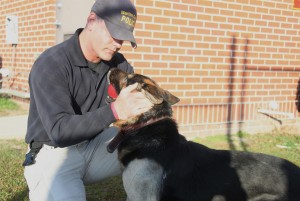Face of Defense: Military Dog Survives Snakebite
MARINE CORPS AIR STATION CHERRY POINT, N.C., Dec. 22, 2011 – Dingo, a 5-year-old Marine Corps military working dog, has survived a bout with a poisonous snake.

U.S. Marine Corps photo by Lance Cpl. Cory D. Polom | Marine Corps Cpl. Stacy K. Chester, a military working dog handler, pets his partner, Dingo, a 5-year-old German shepherd, at Marine Corps Air Station Cherry Point, N.C., Dec. 15, 2011. Dingo survived a bout with a poisonous snake during a recent base training exercise.
Dingo, a German shepherd, was struck by the snake as he searched the woods during a Dec. 5 training exercise here, said Marine Corps Cpl. Stacy K. Chester, a military working dog handler and Dingo’s partner.
“When I noticed his leg, I called him off to take a look,” Chester said. “It had begun swelling, and I immediately rushed him to the vet.”
Chester said when he got Dingo to the base’s veterinarian, Marine Corps Capt. Curtis R. Cline, they began to shave off the hair on Dingo’s injured leg and found a second puncture wound indicating that Dingo had been bitten by a snake. The vet’s assistants called the local area looking for antivenin to counteract the snake venom.
“Most snakes are hibernating at this time of year,” said Marine Corps 2nd Lt. Lloyd T. Hardee, kennel master for the base’s military working dogs. “With the weather changing so drastically over the last month from cold to warm, these snakes are waking up thinking they are hungry and that is what happened to Dingo.”
Once a snake awakens from hibernation its instinct is to feed and protect itself, Hardee explained. During this period of time venomous snakes don’t have as much control on how much venom they release into a victim. In Dingo’s case, Hardee said, the snake had released a large quantity of venom into his leg causing the swelling to progress quickly.
“When I saw the swelling begin to rush up Dingo’s leg and I knew it was a snake bite. I thought the worst,” Chester said. “After a few phone calls it became apparent no one in the local area had the antivenin we needed for Dingo. I thought I was going to lose my best friend.”
Hardee contacted his supervisors, who informed Marine Corps Col. Philip J. Zimmerman, MCAS Cherry Point’s commanding officer, of the situation.
“The Marine Corps is different with the working dog program than the other branches,” Hardee said. “These dogs belong directly to the air station commanding officer. When Colonel Zimmerman heard what happened and that we needed to get Dingo the treatment and care he needed, he said, ‘Do whatever it takes to get that dog treatment.’”
Cline, the veterinarian, said he called his supervisor to get her advice on the situation.
“When I called my supervisor she told me she was in Norfolk and had the antivenin, and to have the dog transported there for further treatment and care after he was stabilized,” Cline said. Hardee then contacted the search and rescue team with Marine Transport Squadron 1 that flies the HH-46 Sea Knight helicopters fondly known as Pedro.
“My first thoughts when briefed by our operations section was, ‘Wait — a dog?’” said Marine Corps Capt. Brett Malavenda, a pilot with the squadron.
“After being told that it was a working dog, I said, ‘Hey, we have a Marine bitten, let’s get moving,’” Malavenda said. “Those dogs are just as important to this base as the [human] Marines. They protect us and detect bombs that could kill hundreds of Marines. I was happy to fly him.”
Chester flew with the helicopter crew as they took Dingo to Naval Station Norfolk, Va. Dingo spent the next few days there getting treatment for the bite.
“The whole flight I stood by Dingo hoping and praying we would get to Norfolk in time to save his leg as well as his life,” Chester said. “People don’t realize what these dogs mean to their handlers.”
Chester and Dingo returned from Norfolk to Cherry Point on Dec. 8. Dingo’s leg was watched over for the next several days to see if there would be any tissue or muscle loss from his encounter with the slithery serpent. Dingo currently has not lost any muscle or tissue.
“Dingo is doing great,” Hardee said. “He is back to his old self. The only problem we face now is to see if he will be able to conduct the tasks needed from him.”
Chester expressed his gratitude for all involved and knows without their help Dingo could have lost his leg — or even his life.
“They saved my best friend,” Chester said. “My closest family is over 1,500 miles away. I have friends I work with, but Dingo is my best friend. He knows when I’m having a bad day, when I’m upset and when I am ready to go to work.
“If we had to drive him to get the antivenin I wouldn’t have Dingo here with me right now,” he added. “I know that without the teamwork shown by VMR-1 and the vets, Dingo would be dead.”

News Release: U.S. Department of Defense





























